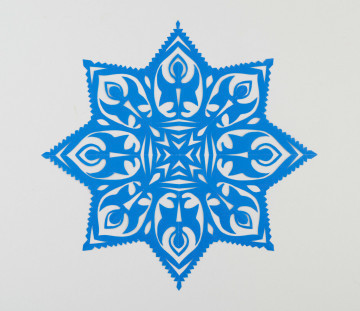
Cutout
2011
National Museum in Lublin
Part of the collection: Folk Art of the Lublin Region (17th–1st half of the 20th c.)
She used sheep shears to create paper cut-outs - sophisticated forms made of paper. Despite its seemingly unwieldy form, this archaic tool was more comfortable than tailor's scissors. When held by the blades and folded, they opened automatically. Thanks to its elasticity, it was possible to cut out human figures (see: E/17674/ML), animal figures, plant arabesques, geometric ornaments (see: E/436/ML) or to serrate the edges with precision. The cut-outs were made without drawing the motifs beforehand, only those with a complicated pattern were sketched on the back.
Glancing paper was used, shiny and smooth, in a few pure colours, which was supplied by Jewish merchants and shopkeepers. In the 1850s, plain paper dyed with home-made dyes replaced it. Folding it along one or more axes determined the shape of the paper cut-out. The final form - circular, square, rosette or star-shaped - was often decided by the artist while working.
Paper cut-outs were part of the household decor. They were pasted on walls, ceiling beams and windows using rye flour glue. Sometimes paper of a different colour was used as a background (see E/457/ML). Openwork forms were used to decorate carol stars; the present one resembles them. White paper was used to cut curtains for windows, sideboard panes and striped decorations of sacred paintings.
After World War I, the custom of decorating cottages with paper cut-outs was rare, and it disappeared after World War II, but interest in paper cut-outs continued. In the Lublin region, distinguished are paper cut-outs by Ignacy Dobrzyński (Garbów-Miesiące, Puławy county) - the creator of the style, on which others modelled and modelled (see: E/433/ML). Intricate paper cut-outs with rich motifs were also made by: Maria Abramiuk (1914-1992, Chmielów, Parczew County), Michalina Krzowska (1907-?, Świdnik), Jan Kamiński (turn of 19th and 20th century, Księżomierz, Kraśnik County) and Bronisław Pietrak (1914-1997, Gutanów, Puławy County), a blacksmith and poet, whose works resemble hinges, cockerels, iron crosses, because he used blacksmith's chisels instead of scissors.
Author / creator
Dimensions
cały obiekt: diameter: 20,5 cm
Object type
cutout
Technique
cutting
Material
Chalk paper
Creation time / dating
Creation / finding place
Owner
The National Museum in Lublin
Identification number
Location / status